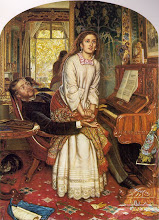
While working with my student on the Cage “Aria” the other day, I starting thinking that John Cage neatly and rather strangely sidestepped all of the most dynamic innovations taking place in the music of his day. “Aria” is a guided improvisation, and a great deal of work in the genre of guided improvisation was going on around the time he wrote it; but the lion’s share of that work was in jazz. The late 1950s saw the flowering of the sons of the bebop generation (like John Coltrane) and the turning of public attention to those who’d been neglected in bebop’s first wave (like Thelonius Monk). Their music was full of warmth, wit, humanity, and vitality. Cage’s music, on the other hand, has wit aplenty, but little warmth, and his aesthetic seems to have been untouched by the most interesting innovations in the music of his day.
The jazz musicians of the 1940s and 50s self-consciously modeled themselves on contemporary European intellectuals, with the ironic twist, of course, that they were black and American; they saw themselves as the true heirs of European harmonic and tonal tradition. John Cage, on the other hand, who admitted that he'd been unable to master the principles of harmony in his studies with Schoenberg in the 1930s, adopted instead the “cold” aesthetic of Japanese Buddhist thought, which, while it may have seemed like a salutary aesthetic cool breeze blowing what was non-essential out of the American ear, ends up going nowhere. This is why Cage has no real heirs in music.
I suppose there are two paths in the art and music of the twentieth century, one of which is a blend of European and African strains, and the other of which is an amalgam of nineteenth-century American transcendalism and authentic Asian practice. Although the ethos of the latter is intriguing, it circles around and bites its own tail; it is self-referential, and its influence is limited. As my brother says, American culture is black culture. Perhaps this is why Cage is so uncompelling: he is, as my friend put it, so short of negritude.
By the way, today is the ninetieth anniversary of Thelonius Monk’s birth. I also happened to see a MetroNorth train car this afternoon named, oddly, the Thelonius Monk.











2 comments:
There's an important addition to that strain of American Transcendentalism, which I would idenitfy heavily with the classical liberal white American Protestant strain in American culture, and that is Charles Ives. His Transcendentalism, strived for and achieved often enough, is very much the Emersonian variety. While the experimental side of Cage was something Ives valued, I believe that the lack of human quality and communal spirit, which was heavily idealized and sentimentalized by Ives, was alien to him.
gtra1n, I would love it if you could write a guest post addressing this. Are you game?
Post a Comment